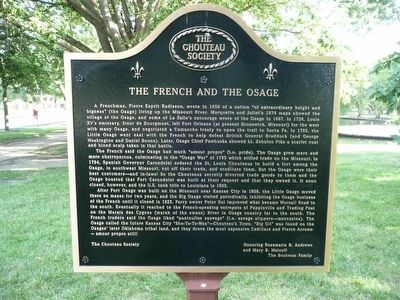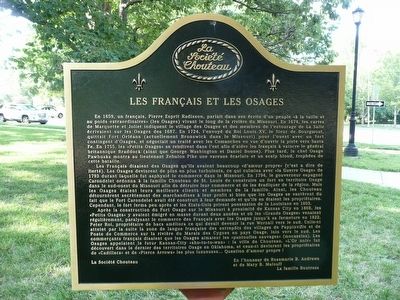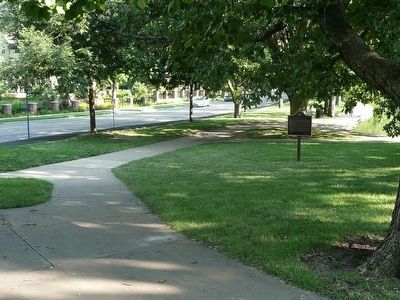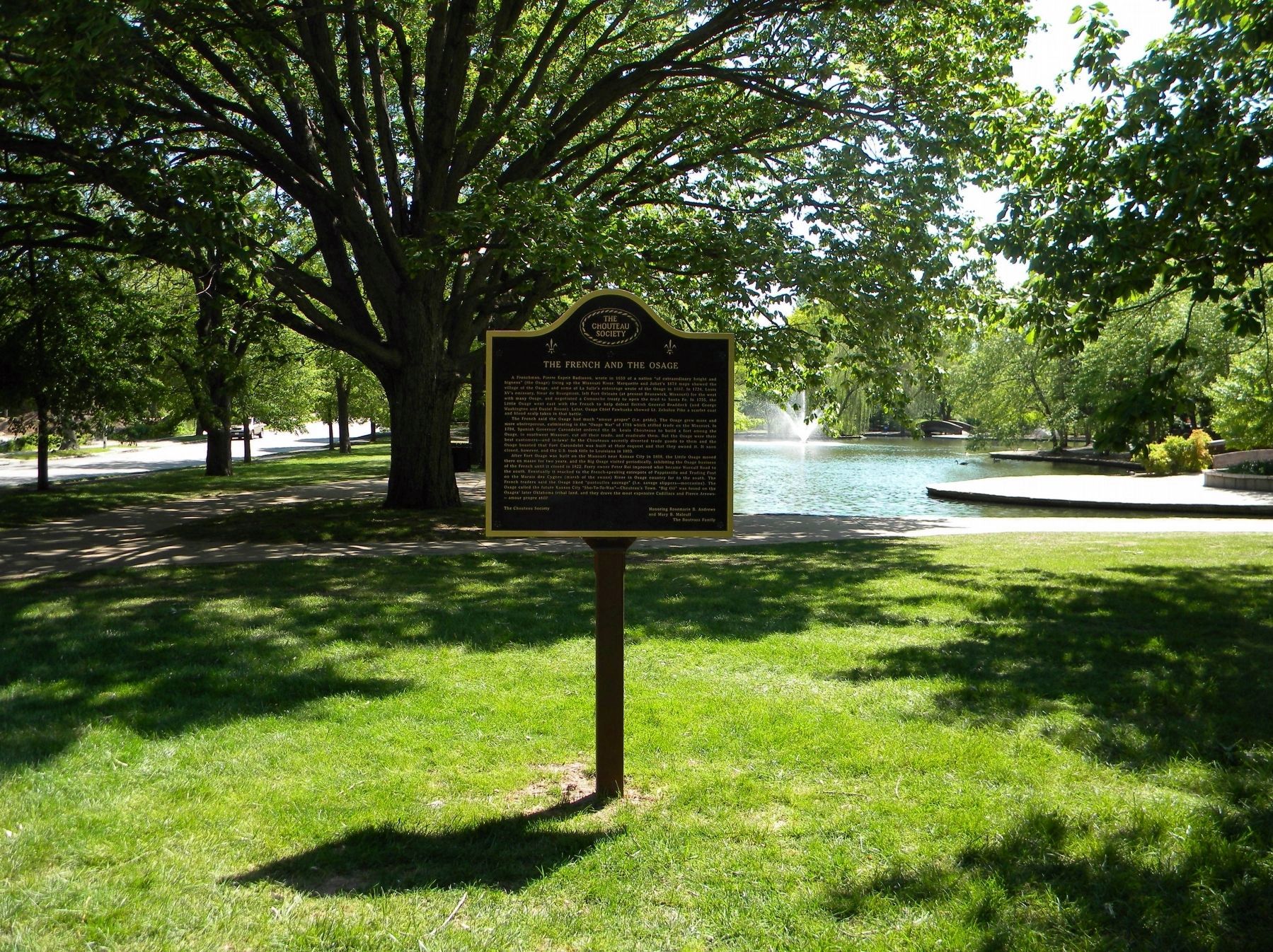Countryside in Kansas City in Jackson County, Missouri — The American Midwest (Upper Plains)
The French and the Osage
English Side
A Frenchman, Pierre Esprit Radisson, wrote in 1659 of a nation” of extraordinary height and bigness” (the Osage) living up the Missouri River. Marquette and Joliet’s 1674 maps show the village of the Osage, and some of La Salle’s entourage wrote of the Osage in 1687. In 1724, Louis XV’s emissary, Sieur de Bourgmont, left Fort Orleans (at present Brunswick, Missouri) for the west with many Osage, and negotiated a Comanche treaty to open the trail to Santa Fe. In 1755, the Little Osage went east with the French to help defeat British General Braddock (and George Washington and Daniel Boone). Later, Osage Chief Pawhuska showed Lt. Zebulon Pike a scarlet coat and blond scalp taken in that battle.
The French said the Osage had much “amour propre” (i.e. pride). The Osage grew more and more obstreperous, culminating in the “Osage War” of 1793 which stifled trade on the Missouri. In 1794, Spanish Governor Carondelet ordered the St. Louis Chouteaus to build a fort among the Osage, in southwest Missouri, cut off their trade, and eradicate them. But the Osage were their best customers – and in-laws! So the Chouteaus secretly diverted trade goods to them and the Osage boasted that Fort Carondelet was built at their request and that they owned it. It soon closed, however, and the U.S. took little to Louisiana in 1803.
After Fort Osage was built on the Missouri near Kansas City in 1808, the Little Osage moved there en masse for two years, and the Big Osage visited periodically, inhibiting the Osage business of the French until it closed in 1822. Ferry owner Peter Roi improved what became Wornall Road to the south. Eventually it reached to the French-speaking entrepots of Pappinville and Trading Post on the Marais des Cygnes (march of the Swans) River in Osage county far to the South. The French traders said the Osage liked “pantoufles sauvage” (i.e. savage slippers – moccasins). The Osage called the future Kansas City “Sho-To-To-Wan” – Chouteau’s Town. “Big Oil” was found on the Osages’ later Oklahoma tribal land, and they drove the most expensive Cadillacs and Pierce Arrows – amour proper still!
French Side
En 1659, un français, Pierre Esprit Radisson, parlait dans ses écrits d'un peuple «à la taille et au poids extraordinaires» (les Osage) vivant le long de la rivière hauteur de la rivière du Missouri. En 1674, les cartes de Marquette et Joliet indiquent le village des Osages et des membres de l'entourage de La Salle écrivaient sur les Osage en 1687. En 1724, l'envoyé du Louis XV, le Sieur de Bourgmont, a quittait Fort Orléans (actuellement Brunswick dans la Missouri) pour l'ouest avec un fort contingent d'Osages, et négociait un traité avec les Comanches en vue d'ouvrir la piste vers Santa Fe. En 1755, les «Petites Osage» se rendirent dans l'est afin d'aider les français à vaincre le général britannique Braddock (ainsi que George Washington et Daniel Boone). Plus tard, le chef Osage Pawhuska montra au lieutenant Zebulon Pike une vareuse écarlate et un scalp blond, trophées de cette bataille.
Le Français disaient des Osages qu'ils avaient beaucoup «d'amour-propre» (c’est à dire de fierté). Les Osages devinrent de plus en plus turbulents, ce qui culmina avec «la Guerre Osage» de 1793 durant laquelle fut asphyxié le commerce dans le Missouri. En 1794, le gouverneur espagnol Carondelet ordonna à la famille Chouteau de St. Louis de construire un fort en territoire Osage, dans le sud-ouest du Missouri afin de détruire coupé leur commerce et de les éradiquer de la région. Mais les Osages étaient leurs meilleurs clients et membres de la famille. Ainsi, les Chouteau détournèrent secrètement des marchandises à leur profit si bien que les Osages se vantèrent du fait que le Fort Carondelet avait été construit à leur demande et qu'ils en étaient les propriétaires. Cependant, le fort ferma pue après et les États-Unis prirent possession de la Louisiane en 1803.
Après la construction du Fort Osage sur le Missouri à proximité de Kansas City en 1808, les «Petits Osage» y avaient émigré en masse durant deux années et où les «Grand Osage» venaient régulièrement, paralysant le commerce des Français avec les Osages jusqu'à sa fermeture en 1822. Peter Roi, propriétaire de bacs améliora ce qui devait devenir la rue Wornall vers le sud. Celle-ci atteint par la suite la zone de langue française des entrepots des villages de Pappinville et de Poste de Commerce sur la rivière du Marais des Cygnes en pays Osage, loin vers le Sud. Les commerçants français disaient que les Osages aimaient les «pantoufles sauvage» ( mocassins). Les Osages appelaient le futur Kansas-City «Sho-To-To-Wan» : la ville de Chouteau. «L'Or noir» fut découvert dans a dernier des territoires Osage en Oklahoma, et ceux-ci devinrent les propriétaires de «Cadillacs» et de «Pierce Arrows» les plus luxueuses… Question d'amour propre!
Erected by Chouteau Society.
Topics. This historical marker is listed in these topic lists: Native Americans • Settlements & Settlers • War, French and Indian. A significant historical year for this entry is 1659.
Location. 39° 1.941′ N, 94° 35.543′ W. Marker is in Kansas City, Missouri, in Jackson County. It is in Countryside. Marker is on Wornall Road, on the right when traveling south. Enter Loose Park off Wornall at the entrance near 51st Street. Follow the circle drive until you are about to exit back on to Wornall. The marker is on your right. Touch for map. Marker is in this post office area: Kansas City MO 64112, United States of America. Touch for directions.
Other nearby markers. At least 8 other markers are within walking distance of this marker. First Home of the Kansas City Country Club (about 700 feet away, measured in a direct line); Centennial Anniversary of Japan's Gift of Cherry Trees (about 700 feet away); Union Artillery (about 800 feet away); McGhee's Charge (about 800 feet away); Carolyne Farwell Fuller (approx. 0.2 miles away); Confederate Position (approx. ¼ mile away); Battle of Westport (approx. 0.3 miles away); a different marker also named Battle of Westport (approx. 0.4 miles away). Touch for a list and map of all markers in Kansas City.
Regarding The French and the Osage. The Chouteau Society, now under the care of the Jackson County Historical Society, was founded in 1984 to promote French heritage in the Midwest. In the 1980s, they created nine markers - later adding two more - to tell the history of the French in the area. These signs were intended to be visited in a sequence as part of tour as indicated in their brochure (which saw multiple editions) called "A Tour of Old French Kansas City." I have entered them in sequence above, according to the brochure. Here is the website: http://jchs.org/chouteau-society/
Related markers. Click here for a list of markers that are related to this marker. A Tour of Old French Kansas City
Credits. This page was last revised on February 10, 2023. It was originally submitted on July 28, 2015, by Michael W. Kruse of Kansas City, Missouri. This page has been viewed 739 times since then and 44 times this year. Photos: 1, 2, 3. submitted on July 28, 2015, by Michael W. Kruse of Kansas City, Missouri. 4. submitted on October 1, 2019, by Michael E Sanchez, Jr. of Kansas City, Missouri. • Bill Pfingsten was the editor who published this page.



